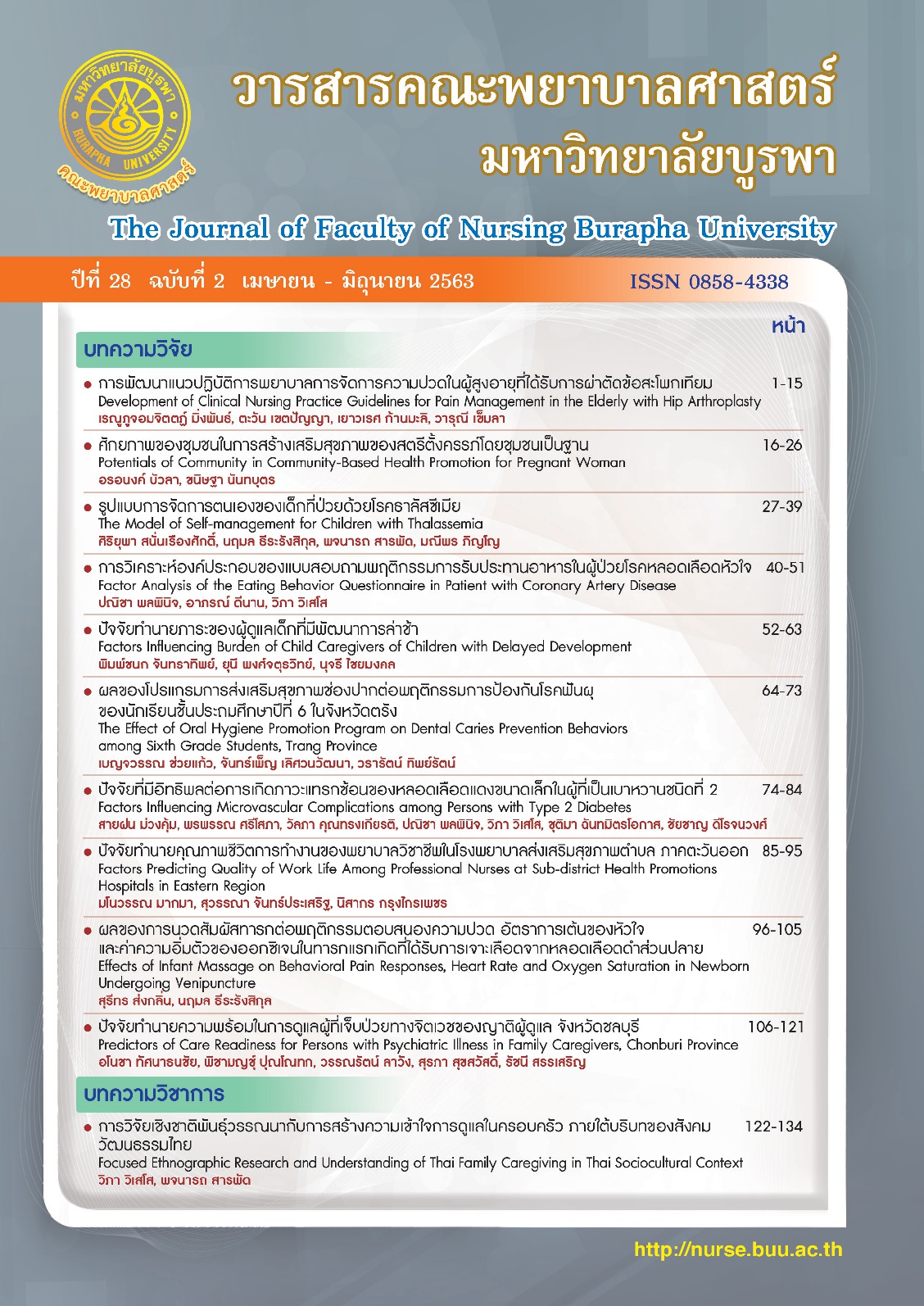การพัฒนาแนวปฏิบัติการพยาบาลการจัดการความปวดในผู้สูงอายุ ที่ได้รับการผ่าตัดข้อสะโพกเทียม
คำสำคัญ:
การจัดการความปวด, ผู้สูงอายุ, การผ่าตัดข้อสะโพกเทียมบทคัดย่อ
การผ่าตัดข้อสะโพกเทียมมีอัตราเพิ่มมากขึ้น เนื่องจากกระดูกสะโพกหักเป็นปัญหาที่พบบ่อยและเพิ่มตามอายุ
ของในผู้สูงวัย การวิจัยและพัฒนานี้มีวัตถุประสงค์เพื่อพัฒนาและศึกษาผลของการใช้แนวปฏิบัติการพยาบาลการจัดการ
ความปวดในผู้สูงอายุที่ได้รับการผ่าตัดข้อสะโพกเทียม กลุ่มตัวอย่างคือ ผู้สูงอายุที่ได้รับการผ่าตัดข้อสะโพกเทียม
ในโรงพยาบาลกาฬสินธุ์ ระหว่างเดือนเมษายน ถึง มิถุนายน 2562 จำนวน 30 คน และพยาบาลที่ปฏิบัติงานที่หอผู้ป่วย
กระดูก จำนวน 15 คน เครื่องมือที่ใช้คือ แนวปฏิบัติการพยาบาล แบบสอบถามผลลัพธ์การจัดการความปวด แบบประเมิน
ประสิทธิภาพของแนวปฏิบัติการพยาบาล และแบบสอบถามความพึงพอใจ วิเคราะห์ข้อมูลด้วยสถิติพรรณนา
ผลการศึกษา พบว่า การจัดการความปวดในผู้สูงอายุที่ได้รับการผ่าตัดข้อสะโพกเทียมมี 4 ระยะคือ การพยาบาล
ระยะก่อนผ่าตัด ขณะผ่าตัด หลังผ่าตัด และระยะต่อเนื่องเพื่อป้องกันความปวดเรื้อรัง ผู้สูงอายุร้อยละ 90 มีระดับ
ความปวดลดลงที่หลังผ่าตัด 72 ชั่วโมงอยู่ในระดับปานกลาง ผู้สูงอายุพึงพอใจต่อการจัดการความปวดโดยรวมอยู่ในระดับ
มาก ( = 27.21, x¯ SD = 1.07) พยาบาลทุกคนใช้วิธีการจัดการความปวดโดยใช้ยา ปัญหาสุขภาพผู้สูงอายุระยะยาว
ในชุมชนพบว่า ผู้สูงอายุร้อยละ 80 มีภาวะพึ่งพาอยู่ในระดับปานกลาง แนวปฏิบัตินี้มีประสิทธิภาพด้านการนำไปใช้
ประโยชน์อยู่ในระดับมากที่สุด ( x = 5.95, ¯ SD = 0.22) ผลการวิจัยนี้เสนอว่าควรมีการนำแนวปฏิบัติการพยาบาล
การจัดการความปวดในผู้สูงอายุที่ได้รับการผ่าตัดข้อสะโพกเทียมไปใช้ในการดูแลผู้ป่วยตั้งแต่ระยะก่อนผ่าตัดจนถึง
หลังผ่าตัดทั้งในโรงพยาบาลทั่วไปและโรงพยาบาลชุมชน โดยปรับให้เหมาะสมกับบริบทการดูแลผู้ป่วย และควรศึกษา
ประสิทธิภาพด้านค่าใช้จ่ายและวันนอนโรงพยาบาล
เอกสารอ้างอิง
Menon, M. R., Majumdar, S. R., Wilson, D. M., Karkhaneh, M., Mousavi ,S. S., Wong, K.,
Tjosvold, L., & Jones, C. A. (2011). Comparative effectiveness of pain management
interventions for hip fracture: A systematic review. Annals of internal medicine, 155(4),
234-245.
American Society of Anesthesiologists Task Force on Neuraxial Opioids, Horlocker, T. T.,
Burton, A. W., Connis, R. T., Hughes, S. C., Nickinovich, D. G., Palmer, C. M., Pollock, J. E.,
Rathmell, J. P., Rosenquist, R. W., Swisher, J. L., & Wu, C. L. (2009). Practice guidelines
for the prevention, detection, and management of respiratory depression associated
with neuraxial opioid administration. Anesthesiology, 111(2), 218-230.
Balen, R.V., Essink-Bot, M.L., Steyerberg, E.W., Cools, H.J., & Habbema, J.D. (2003). Quality of life after hip fracture: a comparison of four health status measures in 208 patients. Journal Disability and Rehabilitation. 25(10), 509-519.
Craig, J.V., Smyth, R.L. & Mullally, S. (2002). The evidence-based practice manual for
nurse. Edinburg: Cherchill Livingstone.
Gélinas, C., Arbour, C., Michaud, C., Vaillant, F., Desjardine, S. (2011). Implementation of the
critical-care pain observation tool on pain assessment/management nursing practices
in an intensive care unit with nonverbal critically ill adults : a before and after
study. Int J Nurs Stud, 48, 1495-504.
Gujol, M. C. (1994). A survey of pain assessment and management practices among critical
care nurses. American Journal of Critical Care, 3(2), 123-128.
Intaranongpai S., Khetphanya T., Thipsuphanphew T., Kam S., Senchai L., Chantakat A.,
Jumroonboon W., & Sornprang S. (2015). Chronic pain situational analysis and pain
management through community participation. Journal of Humanities and Social
Sciences, Mahasarakham University, 10(special), 412-421. [In Thai]
Jiarpinitnun J., (2014). The role of nurse anesthetists nurse in taking care of patients who
have been examined and treated for vascular disorders, nervous systems in
Ramathibodi Hospital. Ramathibodi Nursing Journal, 10(2), 92-100. [In Thai]
Jones, L. E. (2010). First steps: The early years of IASP 1973-1984. Seattle, Washington:
IASP Press.
Khetpanya, T., & Suwannimitr, A. (2015). Outcome of care among pre surgery breast cancer
patients in fast track surgery. The 11th Mahasarakham university research conference
(pp. 486-491). Mahasarakham: Sarakhamprinting. [In Thai]
Klaewklong, S., Chanruangvanich, W., Danaidutsadeekul, S., & Riansuwan, K. (2014). Relation
of comorbidity, grip strength and stress to hip fracture patients’ post-operative
functional recovery. Thai journal of Nursing Council, 29(2), 36-48. [In Thai]
Kleinpell, R. M. (2017). Outcome assessment in advanced practice nursing (4th ed.).
New York, NY: Springer Publishing.
Lau, E. M. C. (2009). The epidemiology of osteoporosis in Asia. International Osteoporosis
Foundation, 6(11), 190-193.
Leelerdmongkolkul, W., Danaidutsadeekul, S., Chanruangvanich, W., & Udomkiat, P. (2013).
The relationship between body mass index, pain, social support and the activity
daily living during recovery phase in hip arthroplasty patients. Journal of Nursing
Scince, 31(2), 26-37. [In Thai]
Meelap, L., Saensom, D., & Methakanjanasak, N. (2017). Clinical nursing practice guideline
for acute pain management in critically ill patients. Srinagarind Medical Journal,
32(6). 561-570. [In Thai]
Melnyk, B.M. & Fineout-Overholt, E. (2005). Evidence-based practice in nursing and healthcare: A guide to best practice. Philadelphia: Lippincott William & Wilkins.
Ngamkham, S., Krutchan, N., Sawangchai, J., Wattanakul, B., Chidnayee, S., & Kiewcha-um, R.
(2018). Knowledge about Pain Assessment and Management of Thai Nurses. Journal
of Nursing and and Health Care, 36(1), 81-89. [In Thai]
Peeters, C. M., Visser, E., Van de Ree, C. L., Gosens, T., Den Oudsten, B. L., & De Vries, J.
(2016). Quality of life after hip fracture in the elderly: A systematic literature review.
International Journal of the Care of the Injury, 47(7), 1369-1382.
doi: 10.1016/j.injury.2016.04.018
Pitantananukune, P. & Surit, P. (2011). Chronic pain management of older persons living in a
community. Journal of Nurses’ Association of Thailand, North-Eastern Division, 29(4),
58-68. [In Thai]
Seiger, C.P., & Wiese, B.S. (2009). Social support from work and family domains
as an antecedent or moderator of work-family conflict? Journal of Vocational
Behavior, 75(1), 26-37. DOI: 10.1016/j.jvb.2009.03.001
Soukup, S, M. (2000). The center for advanced nursing practice evidence-based practice
model: Promoting the scholarship of practice. Nursing Clinics of North America, 35(2),
301‐309.
Thai association for the study of pain (TASP). (2019). Clinical guidance for acute pain
Management. Retrieved January 9, 2019, from
http://www.anesthai.org/public/rcat/Documents/ [In Thai]
The National Guideline Clearinghouse. (2007). Retrieved January 19, 2019, from http://www.
ahrq.gov/research/findings/factsheets/errors-safety/ngc/national-guideline-
clearinghouse.html
The royal college of anesthesiologists of Thailand and Thai association for the study of pain.
(2012). Guideline for acute pain relief after pain surgery. Bangkok: Tanaplace,
[In Thai]
Tiloksakulchai, F. (2006). Concepts and importance of evidence-based practice in the
implementation of empirical evidence: Principles and practices. (5th ed.).
Bangkok: Pee-one. [In Thai]
Yooyod, S. & Wongnaya, S. (2010). Development of practice guideline for postoperative pain
recovery room at Kamphaeng Phet hospital. The Golden Teak: Humanity and Social
Sciences Journal, 16(1), 156-167. [In Thai]





